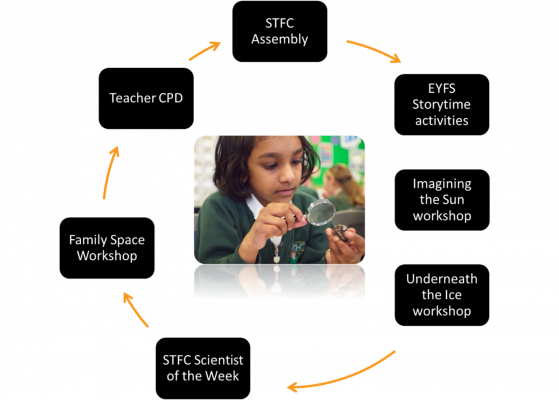2025 update:
The poetry written by Katrina Porteous for Exploring Extreme Environments was published as part of her 4th poetry collection called ‘Rhizodont’.
We were delighted to find out that Rhizodont has won the Laurel Prize for poetry. Congratulations, Katrina!
Project Overview
Exploring Extreme Environments (E3) was a cross-curricular schools science and arts project funded by the Science and Technology Facilities Council.
Over three years, children and their teachers and families, met professionals from the arts and sciences to investigate how we understand extreme environments found across the Sun-Earth connection: from the intense heat of the Sun’s corona to the sub-zero conditions of Antarctica.
The project started in September 2018 and ran over 39 months until December 2021.
Aims of E3
- SHOWCASE STFC research and facilities
- BUILD science capital in low science-capital families and communities in the North East
- INCREASE the confidence of primary school teachers to teach science and technology
- DEVELOP the public engagement capacity of researchers and academics at Northumbria University.
Activities Overview
Each year schools were able to choose from a menu of the following activities:
Description of Activities
- Whole School Assemblies
Yearly assemblies introduced the idea of the work of STFC scientists and technologies: Introducing Extreme Environments, Big Telescopes and satellites and Earth Observation. - Imagining the Sun Workshop
A cross-curricular art–science workshop for children in Year 3 about solar physics and the development of children’s artwork in response to learning. - Underneath the Ice Workshop
A cross-curricular literacy-science workshop for children in Year 5, about Earth Observation and Ice Core analysis in the Antarctic , and the development of children’s poetry in response to learning. - Story-time activity sessions
Space explorers: Pre-school and nursery children read a space-themed story book (‘Are we nearly there yet?’) and then explored robotic exploration of extreme environments in the Solar System using Duplo.
Robots: Pre-school and nursery children read a book about robots (‘Robots, Robots, everywhere’) and then use a simple game to ‘program’ a robot to move on the surface of Mars. - Family Exploration Workshops
Families worked together build and refine blades for a wind turbine using the context of the Princess Elisabeth Research Station, the first net zero Antarctic base. - STEM Person of the Week
A five-week whole-school project in which teachers to showcase the character attributes, rather than achievements, of scientists. STFC scientists and engineers were used as the role models within these postcards. - Teacher Continuing Professional Development
This was aimed at building scientific knowledge and understanding of scientific processes. - Poetry and Sound performance
‘Under the Ice’ is a immersive poetry performance and soundscape developed by poet Katrina Porteous, and composer Peter Zinovieff, in response to research from Northumbria University’s Cold and Palaeo-Environments team.
Summary of Evaluation Findings
The full evaluation report of the E3 project is available to read here.
For a summary see below:
E3 Evaluation Graphic (1)After attending the Underneath the Ice workshop in school, Archie was inspired to continue his learning at home and made his own ice core.
“I am really proud as a subject leader that we have worked alongside NUSTEM over the course of the project. I feel like we have raised the profile of science and engineering in our school at a time when this was perhaps not the easiest to do. All of the lessons in school have been heavily disrupted through Covid – right in the middle of the sample of work – but despite this the children who took part were certainly encouraged to think scientifically and hopefully inspired to do this outside of the taught lessons too.”
Richard Dutton, Albany Village


